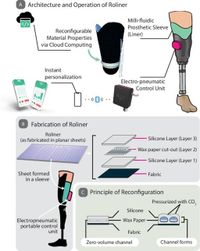A groundbreaking new material named Roliner, designed to revolutionize the field of prosthetics, has emerged from recent research into dynamically adaptive interfaces for wearable devices. This innovative silicone elastomer, embedded with millifluidic channels, provides a solution to a long-standing challenge in prosthetic fitting, particularly for amputees whose residual limbs change shape over time.
Currently, over 2.1 million people in the United States live with limb loss, a figure expected to double by 2050 due predominantly to diabetes-related health issues. Despite advancements in prosthetic technology, many amputees still struggle with prosthetics that do not fit effectively due to the natural changes in their residual limbs. Traditional prosthetic sockets, often custom-made through lengthy and tedious processes, can exacerbate the discomfort and lead to skin issues or even further amputation when the fit is suboptimal.
Researchers have turned to soft robotics to alter the conventional approach to prosthetic liners, creating Roliner as a solution. This adaptable liner operates by adjusting its material properties and volume based on the user’s requirements in real-time, effectively personalizing the fit at the push of a button. Its design boasts low-cost silicone materials that can be pneumatically actuated to deliver a fitting experience tailored to individual activities and conditions.
In ways previous designs failed, Roliner can modulate its hardness and shape dynamically, enhancing both comfort and control for the wearer. Preclinical trials have demonstrated that Roliner significantly improves fitting compared to standard passive liners—essentially a game-changer for the way amputees engage with their prosthetic limbs. During trials, amputees reported significant improvements in comfort, proving Roliner to be a potential new gold standard in prosthetic liner design.
One of the standout features of Roliner is its capacity to achieve consistent actuation forces. In laboratory testing, when all four zones of the prosthetic were activated using pneumatic pressure, the actuation force reached up to 900 Newtons, far surpassing the mere 35 Newtons generated by traditional passive liners. This adaptability not only enhances the suspension and stability of prosthetics during ambulation but also greatly extends the lifespan of existing sockets, easing the financial burden often faced by amputees seeking new fittings.
The core of Roliner’s technological ingenuity lies in its electro-pneumatic control unit that manages the pressure of the embedded channels seamlessly. Designed for robust usability, this lightweight unit can be controlled via Bluetooth, allowing users to adjust settings from their smartphones or other mobile devices. This responsive technology is critical, as it simplifies user interaction and encourages personal engagement with the prosthetic.
Roliner was validated in a set of preclinical human trials that utilized motion-capture technology and participant-reported outcome measures to gather comprehensive feedback on its performance. These trials focused on walking metrics like cadence and vertical ground reaction force, assessing improvements that Roliner delivered over conventional passive liners. Results showed that amputees retained their natural gait, which is pivotal for their mobility and quality of life.
This revolutionary technology promises not just to improve the lives of existing amputees but to redefine how prosthetics are designed and manufactured. By eliminating the need for highly skilled technicians to produce custom sockets, and providing an off-the-shelf solution that can adapt over time, Roliner aims to minimize wait times and improve accessibility worldwide.
Despite the promising advantages, challenges remain. Current development costs for Roliner's components stand at approximately $50 per unit, with the control unit priced around $700. Researchers anticipate these costs to decrease with mass production, making the technology more attainable for global markets, especially in regions where access to high-quality prosthetics is limited.
Future plans include integrating additional functionalities into Roliner, such as continuous health monitoring through wearable sensors. With potential applications extending beyond prosthetics to knee braces, exoskeletons, and other adaptive devices, its foundational technology promises exciting possibilities in wearable health technologies.
Overall, Roliner embodies a significant step forward in prosthetic technology, marrying comfort with functionality in unprecedented ways. This innovative material, while addressing the critical fitting challenge faced by amputees, opens up new avenues for research and development in the realm of soft robotics, suggesting a more personalized approach to wearable health devices.




